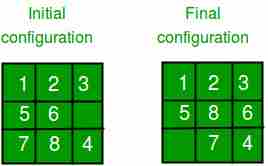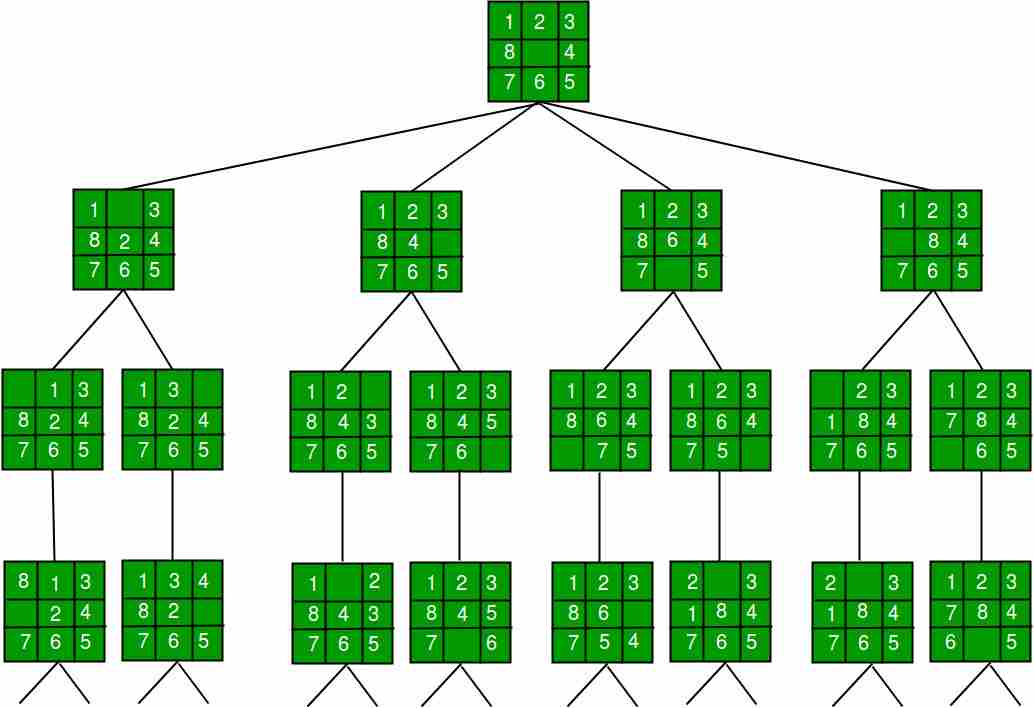我们已经介绍了分枝定界,并在下面的文章中讨论了0/1背包问题。
在这个谜题中,我们讨论了8个谜题的解。 给定一块3×3的板,有8块瓷砖(每个瓷砖有一个1到8之间的数字)和一个空白。目的是将数字放在瓷砖上以匹配 这个 使用空空间进行最终配置。我们可以滑动四个相邻的(左、右、上方) , (下图)将瓷砖铺入空白区域。
例如

1.DFS(蛮力) 我们可以在状态空间(给定问题的所有配置集,即从初始状态可以到达的所有状态)树上执行深度优先搜索。

在这个解决方案中,连续的行动可以让我们远离目标,而不是让我们更接近目标。无论初始状态如何,状态空间树的搜索都遵循从根开始的最左侧路径。在这种方法中可能永远找不到应答节点。
2.BFS(蛮力) 我们可以在状态空间树上执行广度优先搜索。这总是找到一个离根最近的目标状态。但无论初始状态是什么,算法都会尝试像DFS一样的移动序列。
3.分支和绑定 通过使用“智能”排序函数(也称为近似代价函数)来避免在不包含答案节点的子树中搜索,通常可以加快搜索答案节点的速度。它类似于回溯技术,但使用类似BFS的搜索。
分支和绑定基本上涉及三种类型的节点 1.活动节点 是已生成但其子节点尚未生成的节点。 2.电子节点 是当前正在探索其子节点的活动节点。换句话说,E节点是当前正在扩展的节点。 3.死节点 是一个生成的节点,不需要进一步扩展或探索。死节点的所有子节点都已展开。
成本函数: 搜索树中的每个节点X都与成本关联。成本函数有助于确定下一个E节点。下一个E节点是成本最低的节点。成本函数定义为:
C(X) = g(X) + h(X) where g(X) = cost of reaching the current node from the root h(X) = cost of reaching an answer node from X.
理想 成本函数 一 8-谜题算法: 我们假设在任何方向移动一块瓷砖将产生1单位成本。记住这一点,我们为8字谜算法定义了一个成本函数,如下所示:
c(x) = f(x) + h(x) where f(x) is the length of the path from root to x (the number of moves so far) and h(x) is the number of non-blank tiles not in their goal position (the number of mis- -placed tiles). There are at least h(x) moves to transform state x to a goal state
可以使用一种算法来获得未知值h(x)的近似值。
完整算法:
/* Algorithm LCSearch uses c(x) to find an answer node * LCSearch uses Least() and Add() to maintain the list of live nodes * Least() finds a live node with least c(x), deletes it from the list and returns it * Add(x) adds x to the list of live nodes * Implement list of live nodes as a min-heap */struct list_node{ list_node *next; // Helps in tracing path when answer is found list_node *parent; float cost;} algorithm LCSearch(list_node *t){ // Search t for an answer node // Input: Root node of tree t // Output: Path from answer node to root if (*t is an answer node) { print(*t); return; } E = t; // E-node Initialize the list of live nodes to be empty; while (true) { for each child x of E { if x is an answer node { print the path from x to t; return; } Add (x); // Add x to list of live nodes; x->parent = E; // Pointer for path to root } if there are no more live nodes { print ("No answer node"); return; } // Find a live node with least estimated cost E = Least(); // The found node is deleted from the list of // live nodes }}
下图显示了上述算法所遵循的路径,以从8字谜的给定初始配置到达最终配置。请注意,只有成本函数值最小的节点才会展开。
![图片[3]-8.使用分枝定界的谜题-yiteyi-C++库](https://www.yiteyi.com/wp-content/uploads/geeks/20210129/geeks_puzzle81-215x300.jpg)
C++14
// Program to print path from root node to destination node // for N*N -1 puzzle algorithm using Branch and Bound // The solution assumes that instance of puzzle is solvable #include <bits/stdc++.h> using namespace std; #define N 3 // state space tree nodes struct Node { // stores the parent node of the current node // helps in tracing path when the answer is found Node* parent; // stores matrix int mat[N][N]; // stores blank tile coordinates int x, y; // stores the number of misplaced tiles int cost; // stores the number of moves so far int level; }; // Function to print N x N matrix int printMatrix( int mat[N][N]) { for ( int i = 0; i < N; i++) { for ( int j = 0; j < N; j++) printf ( "%d " , mat[i][j]); printf ( "" ); } } // Function to allocate a new node Node* newNode( int mat[N][N], int x, int y, int newX, int newY, int level, Node* parent) { Node* node = new Node; // set pointer for path to root node->parent = parent; // copy data from parent node to current node memcpy (node->mat, mat, sizeof node->mat); // move tile by 1 position swap(node->mat[x][y], node->mat[newX][newY]); // set number of misplaced tiles node->cost = INT_MAX; // set number of moves so far node->level = level; // update new blank tile coordinates node->x = newX; node->y = newY; return node; } // bottom, left, top, right int row[] = { 1, 0, -1, 0 }; int col[] = { 0, -1, 0, 1 }; // Function to calculate the number of misplaced tiles // ie. number of non-blank tiles not in their goal position int calculateCost( int initial[N][N], int final[N][N]) { int count = 0; for ( int i = 0; i < N; i++) for ( int j = 0; j < N; j++) if (initial[i][j] && initial[i][j] != final[i][j]) count++; return count; } // Function to check if (x, y) is a valid matrix coordinate int isSafe( int x, int y) { return (x >= 0 && x < N && y >= 0 && y < N); } // print path from root node to destination node void printPath(Node* root) { if (root == NULL) return ; printPath(root->parent); printMatrix(root->mat); printf ( "" ); } // Comparison object to be used to order the heap struct comp { bool operator()( const Node* lhs, const Node* rhs) const { return (lhs->cost + lhs->level) > (rhs->cost + rhs->level); } }; // Function to solve N*N - 1 puzzle algorithm using // Branch and Bound. x and y are blank tile coordinates // in initial state void solve( int initial[N][N], int x, int y, int final[N][N]) { // Create a priority queue to store live nodes of // search tree; priority_queue<Node*, std::vector<Node*>, comp> pq; // create a root node and calculate its cost Node* root = newNode(initial, x, y, x, y, 0, NULL); root->cost = calculateCost(initial, final); // Add root to list of live nodes; pq.push(root); // Finds a live node with least cost, // add its childrens to list of live nodes and // finally deletes it from the list. while (!pq.empty()) { // Find a live node with least estimated cost Node* min = pq.top(); // The found node is deleted from the list of // live nodes pq.pop(); // if min is an answer node if (min->cost == 0) { // print the path from root to destination; printPath(min); return ; } // do for each child of min // max 4 children for a node for ( int i = 0; i < 4; i++) { if (isSafe(min->x + row[i], min->y + col[i])) { // create a child node and calculate // its cost Node* child = newNode(min->mat, min->x, min->y, min->x + row[i], min->y + col[i], min->level + 1, min); child->cost = calculateCost(child->mat, final); // Add child to list of live nodes pq.push(child); } } } } // Driver code int main() { // Initial configuration // Value 0 is used for empty space int initial[N][N] = { {1, 2, 3}, {5, 6, 0}, {7, 8, 4} }; // Solvable Final configuration // Value 0 is used for empty space int final[N][N] = { {1, 2, 3}, {5, 8, 6}, {0, 7, 4} }; // Blank tile coordinates in initial // configuration int x = 1, y = 2; solve(initial, x, y, final); return 0; } |
Python3
# Python3 program to print the path from root # node to destination node for N*N-1 puzzle # algorithm using Branch and Bound # The solution assumes that instance of # puzzle is solvable # Importing copy for deepcopy function import copy # Importing the heap functions from python # library for Priority Queue from heapq import heappush, heappop # This variable can be changed to change # the program from 8 puzzle(n=3) to 15 # puzzle(n=4) to 24 puzzle(n=5)... n = 3 # bottom, left, top, right row = [ 1 , 0 , - 1 , 0 ] col = [ 0 , - 1 , 0 , 1 ] # A class for Priority Queue class priorityQueue: # Constructor to initialize a # Priority Queue def __init__( self ): self .heap = [] # Inserts a new key 'k' def push( self , k): heappush( self .heap, k) # Method to remove minimum element # from Priority Queue def pop( self ): return heappop( self .heap) # Method to know if the Queue is empty def empty( self ): if not self .heap: return True else : return False # Node structure class node: def __init__( self , parent, mat, empty_tile_pos, cost, level): # Stores the parent node of the # current node helps in tracing # path when the answer is found self .parent = parent # Stores the matrix self .mat = mat # Stores the position at which the # empty space tile exists in the matrix self .empty_tile_pos = empty_tile_pos # Storesthe number of misplaced tiles self .cost = cost # Stores the number of moves so far self .level = level # This method is defined so that the # priority queue is formed based on # the cost variable of the objects def __lt__( self , nxt): return self .cost < nxt.cost # Function to calculate the number of # misplaced tiles ie. number of non-blank # tiles not in their goal position def calculateCost(mat, final) - > int : count = 0 for i in range (n): for j in range (n): if ((mat[i][j]) and (mat[i][j] ! = final[i][j])): count + = 1 return count def newNode(mat, empty_tile_pos, new_empty_tile_pos, level, parent, final) - > node: # Copy data from parent matrix to current matrix new_mat = copy.deepcopy(mat) # Move tile by 1 position x1 = empty_tile_pos[ 0 ] y1 = empty_tile_pos[ 1 ] x2 = new_empty_tile_pos[ 0 ] y2 = new_empty_tile_pos[ 1 ] new_mat[x1][y1], new_mat[x2][y2] = new_mat[x2][y2], new_mat[x1][y1] # Set number of misplaced tiles cost = calculateCost(new_mat, final) new_node = node(parent, new_mat, new_empty_tile_pos, cost, level) return new_node # Function to print the N x N matrix def printMatrix(mat): for i in range (n): for j in range (n): print ( "%d " % (mat[i][j]), end = " " ) print () # Function to check if (x, y) is a valid # matrix coordinate def isSafe(x, y): return x > = 0 and x < n and y > = 0 and y < n # Print path from root node to destination node def printPath(root): if root = = None : return printPath(root.parent) printMatrix(root.mat) print () # Function to solve N*N - 1 puzzle algorithm # using Branch and Bound. empty_tile_pos is # the blank tile position in the initial state. def solve(initial, empty_tile_pos, final): # Create a priority queue to store live # nodes of search tree pq = priorityQueue() # Create the root node cost = calculateCost(initial, final) root = node( None , initial, empty_tile_pos, cost, 0 ) # Add root to list of live nodes pq.push(root) # Finds a live node with least cost, # add its children to list of live # nodes and finally deletes it from # the list. while not pq.empty(): # Find a live node with least estimated # cost and delete it form the list of # live nodes minimum = pq.pop() # If minimum is the answer node if minimum.cost = = 0 : # Print the path from root to # destination; printPath(minimum) return # Generate all possible children for i in range (n): new_tile_pos = [ minimum.empty_tile_pos[ 0 ] + row[i], minimum.empty_tile_pos[ 1 ] + col[i], ] if isSafe(new_tile_pos[ 0 ], new_tile_pos[ 1 ]): # Create a child node child = newNode(minimum.mat, minimum.empty_tile_pos, new_tile_pos, minimum.level + 1 , minimum, final,) # Add child to list of live nodes pq.push(child) # Driver Code # Initial configuration # Value 0 is used for empty space initial = [ [ 1 , 2 , 3 ], [ 5 , 6 , 0 ], [ 7 , 8 , 4 ] ] # Solvable Final configuration # Value 0 is used for empty space final = [ [ 1 , 2 , 3 ], [ 5 , 8 , 6 ], [ 0 , 7 , 4 ] ] # Blank tile coordinates in # initial configuration empty_tile_pos = [ 1 , 2 ] # Function call to solve the puzzle solve(initial, empty_tile_pos, final) # This code is contributed by Kevin Joshi |
输出:
1 2 3 5 6 0 7 8 4 1 2 3 5 0 6 7 8 4 1 2 3 5 8 6 7 0 4 1 2 3 5 8 6 0 7 4
资料来源: www.cs。嗯。edu/~sanjiv/classes/cs5130/teachments/bb。pdf https://www.seas.gwu.edu/~bell/csci212/Branch_and_Bound。pdf
本文由 阿迪蒂亚·戈尔 .如果你喜欢GeekSforgek,并想贡献自己的力量,你也可以写一篇文章,然后将文章邮寄给评论-team@geeksforgeeks.org.看到你的文章出现在Geeksforgeks主页上,并帮助其他极客。 如果您发现任何不正确的地方,或者您想分享有关上述主题的更多信息,请写评论


![关于”PostgreSQL错误:关系[表]不存在“问题的原因和解决方案-yiteyi-C++库](https://www.cppku.com/wp-content/themes/zibll/img/thumbnail.svg)





